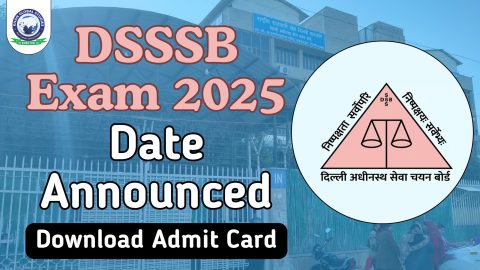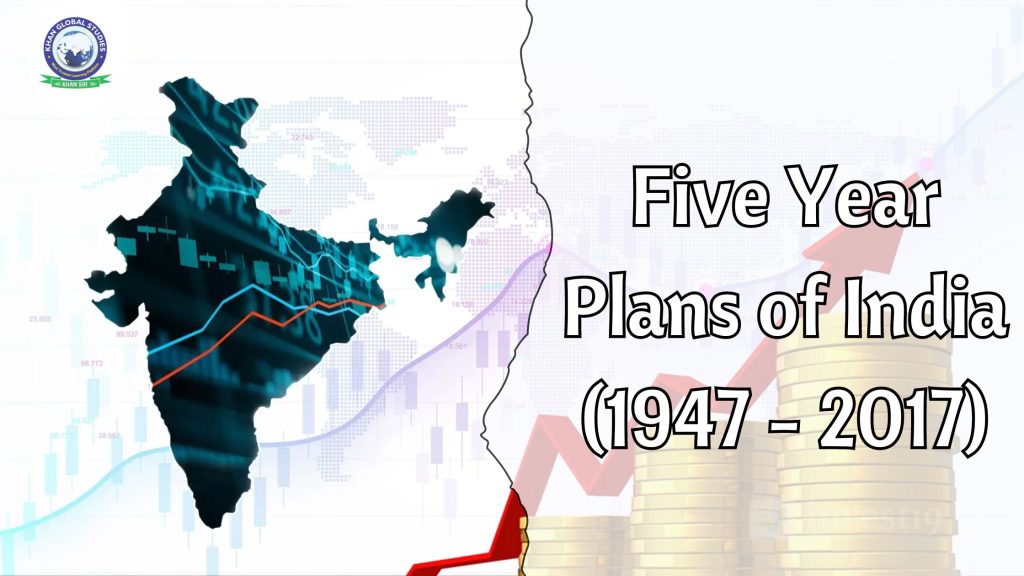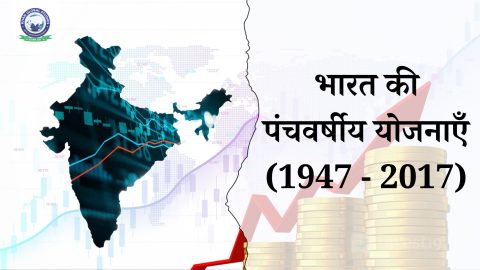Five-year plans are launched every 5 years by the Government of India for the economic and social development of the country. These plans are integrated and centralized national programs for the development of the country.
This is how the Indian economy was planned from 1947 to 2017. It was prepared and implemented by the Planning Commission (1951-2014) and NITI Aayog (2015-2017). The Prime Minister headed the Planning Commission and also had a Deputy Chairman, whose rank was equivalent to that of a Cabinet Minister. Montek Singh Ahluwalia was the last Deputy Chairman of the Commission, who resigned on 26 May 2014. The Twelfth Five-Year Plan ended in March 2017.
The Gadgil Formula was adopted in 1969 to make resource allocation to states more transparent and equitable. Subsequently, central assistance for state plans was determined by this formula. In 2014, the new government dissolved the Planning Commission and replaced it with NITI Aayog (National Institution for Transforming India).
History
The five-year plans were inspired by the Soviet Union, where Joseph Stalin launched the first five-year plan in 1928. India launched its first five-year plan in 1951, inspired by the socialist vision of the then Prime Minister Jawaharlal Nehru. The first plan boosted agricultural production and laid the foundation for industrialisation. The public and private sectors were given important roles in it.
First Five-Year Plan (1951-1956)
The main objective of the first plan was to deal with the partition of the country and the after-effects of World War II. It emphasized the development of agriculture, industry and social services. Under this plan, several irrigation projects were started in India and dams were built in the Bhakra, Hirakud and Damodar valleys. During the first plan, India achieved a growth rate of 3.6%, which was higher than the targeted 2.1%.
Second Five-Year Plan (1956-1961)
The second plan focused on the development of industry and the public sector. The plan followed the Mahalanobis model, which was developed to determine the optimal allocation of investment to productive sectors. Steel plants were set up in Bhilai, Durgapur and Rourkela. Several research institutes were also established in the country during this plan. The actual growth rate of the plan was 4.27%, slightly lower than the targeted 4.5%.
Third Five-Year Plan (1961-1966)
The third plan focused on increasing agriculture and wheat production, but the Indo-China War of 1962 and the Indo-Pakistani War of 1965 affected it. The rupee was also devalued in this plan. The actual growth rate was 2.4%, much lower than the targeted 5.6%.
Fourth Five-Year Plan (1969-1974)
The fourth plan aimed to achieve economic stability and self-reliance. During this plan, Indira Gandhi’s government nationalized 14 major banks and launched the Green Revolution in India. The actual growth rate of the plan was 3.3%, which was lower than the targeted 5.6%.
Fifth Five-Year Plan (1974-1978)
The aim of the Fifth Plan was employment, poverty alleviation and justice. It also focused on self-sufficiency in agriculture and defence. The actual growth rate of the plan was 4.8%, which was higher than the target of 4.4%.
Sixth Five-Year Plan (1980-1985)
The Sixth Plan introduced economic liberalisation in India. It removed price controls and closed ration shops. The actual growth rate of the plan was 5.7%, which was higher than the targeted 5.2%.
Seventh Five-Year Plan (1985-1990)
The Seventh Plan aimed to increase economic productivity and generate employment through social justice. India achieved a growth rate of 6.01% under the scheme, higher than the targeted 5%.
Annual Plans (1990-1992)
Due to the Rapidly Changing Economic Situation at the Centre, the Eighth Plan could not commence in 1990 and the years 1990-91 and 1991-92 were treated as Annual Plans. The Eighth Plan was finally prepared for the period 1992-1997.
Eighth Five-Year Plan (1992-1997)
The Eighth Five-Year Plan marked a shift in India’s economic policies towards a market-oriented economy. Its focus was on modernisation, reducing fiscal deficit and improving public sector productivity. The plan also aimed to create more jobs, increase exports and control population growth.
The plan was successful, with a real growth rate of 6.8%, higher than the target of 5.6%. Several economic reforms were also carried out during this period, including the abolition of the license Raj, reduction of import duties and promotion of foreign direct investment (FDI). These reforms laid the foundation for India’s rapid economic growth in the following decades.
Ninth Five-Year Plan (1997-2002)
The Ninth Plan focused on accelerating economic growth with social justice and equity. The plan aimed to create adequate employment opportunities and provide necessities such as education, health and housing to the general public.
However, the growth rate during this plan was lower than expected, mainly due to the impact of the Asian financial crisis. Despite this, significant achievements were made in the IT and telecommunication sectors, which paved the way for India’s emergence as a global IT hub.
Tenth Five-Year Plan (2002-2007)
The Tenth Five-Year Plan aimed to achieve 8% GDP growth by 2007 and reduce poverty by 5 percentage points. The plan aimed to ensure that the benefits of growth reached all sections of society, especially the poor.
The actual growth rate during this period was 7.7%, slightly lower than the target. The plan also emphasized infrastructure development, agricultural development and human resource development.
Eleventh Five-Year Plan (2007-2012)
The Eleventh Plan targeted an inclusive growth strategy, focusing on health, education and infrastructure. The plan aimed to reduce the poverty rate by 10 percentage points and increase agricultural growth by 4%.
Despite facing global economic challenges, including the 2008 financial crisis, the Indian economy grew at an average rate of about 8% during this period. The plan also focused on improving the quality of education and health services.
Twelfth Five-Year Plan (2012-2017)
The Twelfth Five-Year Plan was the last plan of its kind, as the Government of India decided to replace the Planning Commission with the NITI Aayog in 2015. The plan focused on faster, sustainable and more inclusive growth, with an emphasis on increasing investment in infrastructure, energy and social sectors.
The growth target was set at 8%, but the actual growth rate was lower due to various global and domestic factors. The plan also aimed to improve governance and reduce corruption.
End of Five-Year Plans
In 2015, the Government of India replaced the Planning Commission with the NITI Aayog (National Institution for Transforming India), marking the end of the Five-Year Plans. NITI Aayog focuses on a more decentralised approach to economic planning, encouraging states to develop their strategies for development and growth.
Conclusion
The Five-Year Plans played a key role in shaping India’s economic policies and development strategies over several decades. Each plan reflected the challenges and priorities of its time, adapting to the emerging needs of the nation while striving for growth, stability and self-reliance. The transition from the Planning Commission to NITI Aayog marked the end of an era, as India moved towards a more decentralised approach to development planning.





